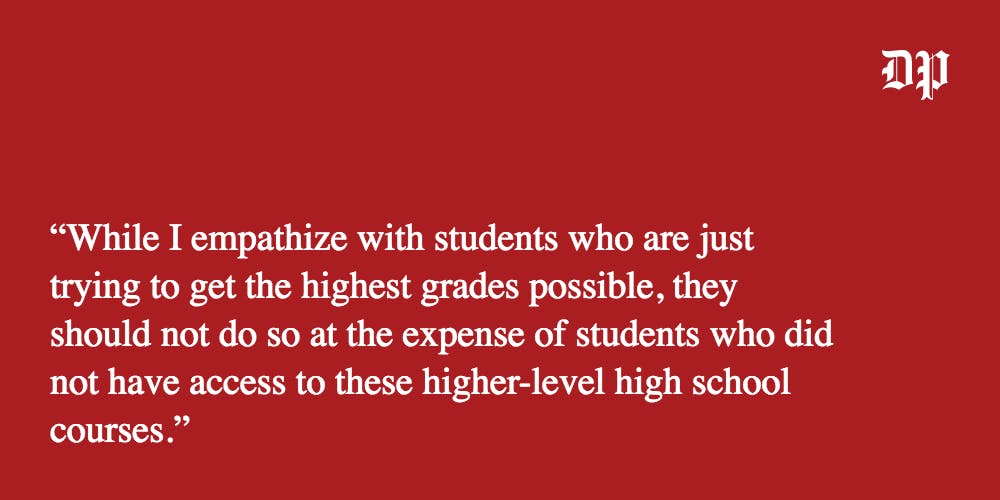
Having a semester at Penn under my belt is a feat in and of itself. Like every other naive first-year student, I wanted to get a 4.0 GPA. However, that was kind of unrealistic. I am sure that some people were able to muster all their effort and get the coveted 4.0 GPA that most Ivy League admits vie for, but that is not the norm. In 2001, across all four undergraduate schools, the average GPA was 3.345.
The concept of “work” in college is different for every student. Some students party all the time and blow off all their coursework, but still manage to get an A. On the other hand, other students who work much harder and put in more effort may still get a lower grade. This is expected, and no matter which side you end up on, there is nothing you can change once the semester comes to a close and you get that dreaded “CITsender email.”
One exciting aspect of attending a university like Penn is being able to take courses in subjects many high schools do not provide. My high school did not offer the Advanced Placement Economics sequence. Some first-generation, low-income students went to high schools that do not have any A.P. or International Baccalaureate courses at all.
However, in my ECON 001 class, not all of my classmates were unfamiliar with the material. I soon realized that some of the other students had taken A.P. Microeconomics in high school, but did not score a 5 on the exam, meaning they had to take the course again at Penn.
John Tierney of The Atlantic argues that A.P. courses and tests don’t accurately reflect the rigor and curriculum taught by top-tier universities. However, these students are still coming into these introductory courses with an advantage: considerable prior knowledge.
Although Penn's curriculum may be a little different, having previous exposure to the course content is beneficial. Anyone in this position would take the opportunity to get an “easy A,” but it is unfair to other students. Some students who have even received a 5 choose to forfeit their credit and repeat the course. These types of students can skew the curves in intro classes such as ECON 001, ECON 002, MATH 103, and MATH 104.
College freshman Rashelle Frederic was also negatively affected by classmates who had already taken the A.P. class.
“Since they didn’t score high enough to waive out," Frederic said, “they hurt the class by destroying the curve because people who are just being introduced to the class don’t think the same way as someone who previously took the class for a whole year."
Penn's A.P. credit policies need to be revised. Some peer institutions award college credit to students who score a 4 on certain A.P. exams. Columbia University gives students credit for the entire economics sequence as long as they received a 4 on one of the A.P. Economics exams and a 5 on the other.
I propose that there should be an accelerated track for students who did satisfactorily in similar courses in high school, but could not achieve a 5 on the placement test. The content would be roughly the same as the regular introductory course — only the course would be taught at a faster pace, allowing for more topics to be covered during the semester.
There should be restrictions on entry-level courses. It is not that hard for a student to convince their advisor to let them take an easier course by saying they did not receive adequate instruction during high school.

Therefore, I believe that if an advisor sees that a student received a B or higher in an A.P. or I.B. course on their high school transcript, they should bar that student from registering for the introductory course. While I empathize with students who are just trying to get the highest grades possible, they should not do so at the expense of students who did not have access to these higher-level high school courses.
By trying to create an equal playing field, some of these introductory classes will seem less daunting. Yet, it would be hard to implement all these rules and rewrite the guidelines that determine students’ placement into courses. Another option would be to grade students on two separate curves: one for those who have taken the A.P. course and one for those who haven't.
At the end of the day, college is a place for collaborative work, but real learning can only be accomplished if everyone is on the same page.

CARLOS ARIAS VIVAS is a College freshman from Stamford, Conn., studying communication. His email address is cariasv@sas.upenn.edu.
The Daily Pennsylvanian is an independent, student-run newspaper. Please consider making a donation to support the coverage that shapes the University. Your generosity ensures a future of strong journalism at Penn.
Donate



